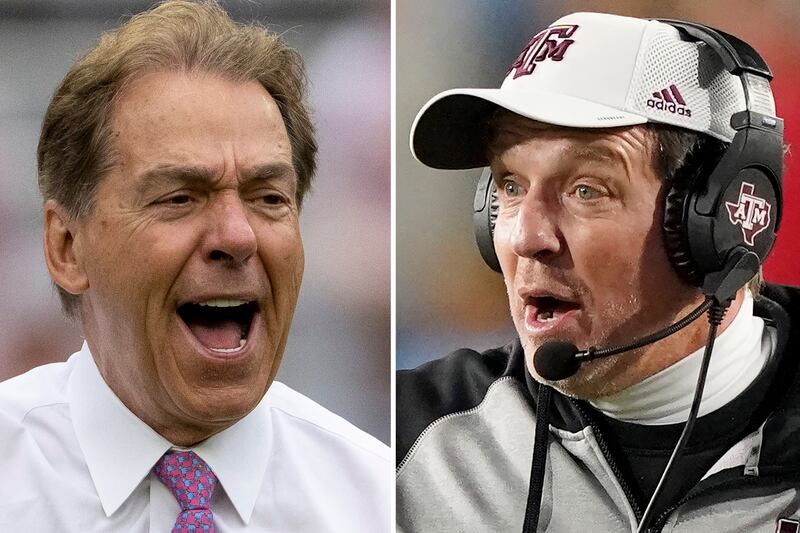The NCAA is trying hard to put some guidelines in place on NIL and the transfer portal. The infighting and name-calling by SEC coaches Nick Saban at Alabama and Texas A&M’s Jimbo Fisher is just a byproduct of the circus.
It’s hard to put the toothpaste back in the tube.
In the past few months, college football and basketball have become a clown show with transfers and NIL deals.
Once the door was opened by the Supreme Court for student-athletes to have more control over their name, likeness and image and actually profit like universities do, it became a real rodeo as some predicted.
The thing is, if you make college sports more like professional sports, you do have to have some boundaries.
What we’ve got now is unlimited free agency and no salary cap. It’s like pigs feeding at a trough, bullying one another, pushing and shoving, as boosters — many of whom have always done shadow deals — step in and take control via off-campus collectives.
It’s amazing what free enterprise can do.
But there should also be prudence in what a 17-year-old can manage financially. Heck, even professional athletes with advisors, agents and financial planners go bust and get in trouble with the tray full of money thrown at them.
When Saban called out Texas A&M for buying his No. 1-ranked recruiting class in 2022, the gloves came off. Fisher immediately reacted, as did his athletic director. You’ve never heard so much name-calling. Fisher called it despicable. The word hypocrite got full run this week.
Deion Sanders, who inked the No. 1 recruit at Jackson State, sensed incoming from Saban, who accused him of paying $1 million for the player. Sanders said he isn’t the guy coaches should pick on with this issue.
“I don’t even wear a watch and I know what time it is. They forget I know who’s been bringing the bag and dropping it off,” Sanders said. “I know this stuff. I’m not the one you want to play with when it comes to all of this stuff.”
I like the tweet sent out by former USC player Su’a Cravens, a former five-star defender out of high school. He saw the hypocrisy in SEC bad blood clear as day.
Cravens said the only schools that didn’t offer him money to play were Pac-12 schools.
Cravens hears what Saban and Fisher are saying and shakes his head.
I remember being told by folks close to Jake Heaps, the highly recruited QB out of Washington who signed with BYU, that Heaps was offered more than $200,000 if he signed with an SEC school.
That was back in 2009.
Before then, the money train was well on the tracks to a myriad of schools we all ooh and aah over for accomplishments.
It is naive to think that before, during and after the SMU scandal in the old Southwest Conference, that college programs didn’t have booster interference and players weren’t paid according to a scale at the going rate by position.
Pointing an accusing finger at Saban and Alabama, Fisher asked reporters to go talk to folks who’ve worked with the legendary coach, and see how he does it.
Boy, if that wasn’t a volley.
The Fisher versus Saban blowup this week was just an instance of spoiled kids calling each other names.
It’s actually funny.
And it’s likely a preamble of P5 schools turning into something else — a semiprofessional league, a breakoff from the NCAA.
What we have now is a lot of dirt out in the open. I’d love to be a fly on the wall at the SEC’s summer football meetings with coaches and athletic directors with Saban and Fisher at the table.
Fisher declared Texas A&M wasn’t doing anything against the rules or the laws of Texas.
He might be right.
But the current Wild, Wild West of NIL deals and signing does seem to go against the singular simple tenet of what the NCAA asked schools not to do — pay for play. It is prohibited.
The nation’s No. 1 receiver Jordan Addison at Pitt announced last week he was transferring to USC. His NIL deal is rumored to be a multimillion-dollar deal.
This is something that will impact Pac-12 foes big time, including Utah.
Thing is, right now, prospective student-athletes out of high school, junior college students and those in the transfer portal are asking for and reacting to pay-for-play scenarios: If they come to a certain school, they can earn a certain amount of money in NIL associations.
Did this happen with Addison, a symbolic figure of this circus? Both Pitt’s coach and the ACC have expressed concerns Addison was tampered with. Sound like an NFL conversation? Yes, it does.
SEC commissioner Greg Sankey told Yahoo Finance this week that what we have now with NIL is just straight payment.
“There are some concerning trends,” said Sankey. “We’re not seeing name image and likeness activity — we’re seeing just straight payments. And I think it’s important that we recenter ourselves on what’s supposed to be happening here and the desire to keep that activity out of recruitment. To benefit young people economically, but to do so in a healthy way.”
What we have now is collectives, spearheaded by boosters, making deals directly to recruits, promising them a certain amount of money if they enroll or transfer — regardless of their NIL value.
“We feel like we’re in a little bit of crisis, a little bit of chaos,” said Penn State athletic director Sandy Barbour to Yahoo.com. “I think ‘chaos’ is the word that’s been used and so, I think we’ve got to find a solution pretty quickly.”
Now, that’s funny. To some extent this has been going on since the ’60s and ’70s with some programs.
Today, it is a free-for-all.
The corral fence is down and it might be too late for a roundup.


